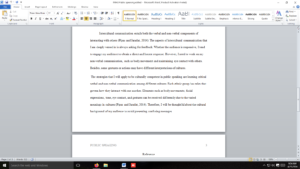Public Speaking
Discussion responses should be on topic, original writing, contribute to the quality of the Discussion by making frequent informed references to course materials and the course textbook (include proper APA in-text citations), and be a minimum of 200 words in length. Please refer to your Discussion Rubric for grading details.
- Identify your communication style and provide a specific example of how this style will affect the way you create and present your speech.
- Explain how your communication style will affect diverse audiences.
- Identify which aspects of intercultural communication are you versed in and which areas you need to work on.
- Discuss what strategies you will use to be more interculturally competent in speaking.
Answer preview
Intercultural communication entails both the verbal and non-verbal components of interacting with others (Pipas and Jaradat, 2014). The aspects of intercultural communication that I am deeply versed in is always asking for feedback. Whether the audience is responsive, I tend to engage my audience to obtain a direct and honest response. However, I need to work on my non-verbal communication, such as body movement and maintaining eye contact with others. Besides, some gestures or actions may have different interpretations of cultures.
The strategies that I will apply to be culturally competent in public speaking are learning critical verbal and non-verbal communication among different cultures. Each ethnic group has rules that govern how they interact with one another. Elements such as body movements, facial expressions, tone, eye contact, and gestures can be received differently due to the varied meanings in cultures (Pipas and Jaradat, 2014). Therefore, I will be thoughtful about the cultural background of my audience to avoid presenting confusing messages.
[322 Words]

Public Speaking

